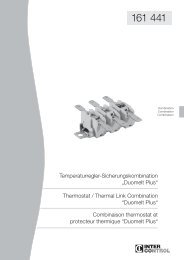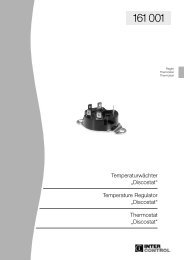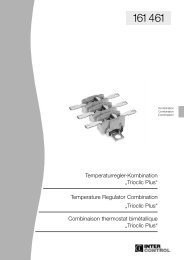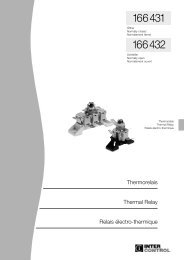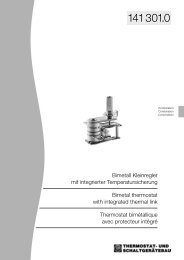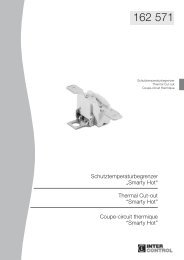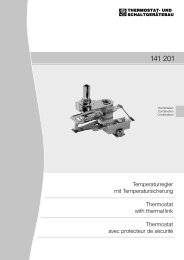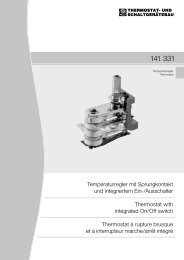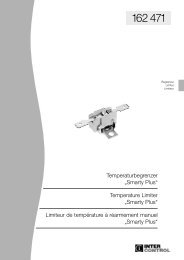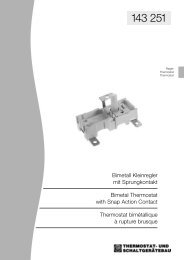Smarty Plus - Produktinfo.conrad.com
Smarty Plus - Produktinfo.conrad.com
Smarty Plus - Produktinfo.conrad.com
You also want an ePaper? Increase the reach of your titles
YUMPU automatically turns print PDFs into web optimized ePapers that Google loves.
Anwendung<br />
Der Temperaturregler Typ 161 471 kann bei<br />
sachgemäßer Anwendung überall dort eingesetzt<br />
werden, wo eine festgelegte<br />
Temperatur geregelt bzw. überwacht werden<br />
soll, wie z. B. in Kaffeemaschinen,<br />
Eierkochern, Mikrowellenöfen etc.<br />
Aufbau und Wirkungsweise<br />
Als Temperaturfühler dient eine gewölbte<br />
Bimetallschnappscheibe. Sie liegt direkt auf<br />
der Grundplatte des Reglers und kann somit<br />
schnell auf Temperaturänderungen reagieren.<br />
Bei Erreichen der festgelegten Abschalttemperatur<br />
bewirkt die Bimetallschnappscheibe<br />
das momentartige Öffnen des elektrischen<br />
Stromkreises. Nach der Abkühlphase<br />
schnappt sie wieder in die ursprüngliche<br />
Position zurück, womit der Stromkreis<br />
wieder geschlossen wird.<br />
Die hochgezogenen Seitenteile des Isolierkörpers<br />
sowie der Flachsteckerübergriff mit<br />
dem feststehenden Kontakt bieten einen<br />
weitgehenden Schutz vor Berührung der<br />
Schaltfeder.<br />
Der ’<strong>Smarty</strong> <strong>Plus</strong>’ ist auch mit einem<br />
Kunststoffdeckel aus Rynite FR 530 30 %<br />
GV lieferbar. Das Material ist bis 180 ºC<br />
beständig.<br />
Ist eine Abdeckung bei Abschalttemperaturen<br />
über 180 ºC nötig, kann eine<br />
Keramikabdeckung mit Klemmfeder angebracht<br />
werden.<br />
Vorteile<br />
- einfache Montage<br />
- schnelle Wärmeübertragung<br />
- große Kontaktöffnungskraft<br />
- Abwälzbewegung der Kontakte<br />
- hohe Lebensdauer<br />
Ausführungen<br />
Die verschiedenen Anschluss- und<br />
Befestigungsmöglichkeiten sind auf der<br />
Rückseite dargestellt.<br />
Application<br />
Properly installed, the temperature regulator<br />
type 161 471 may be used for example in<br />
coffee-machines, egg-boilers, microwaves,<br />
and wherever a fixed temperature needs to<br />
be controlled.<br />
Structure and Function<br />
A vaulted bimetal disc is used as temperature<br />
sensing element. The disc is placed in<br />
direct contact with the mounting plate therefore<br />
reacting quickly to changes in temperature.<br />
Upon reaching the set temperature the<br />
bimetal disc operates and opens the electrical<br />
contacts.<br />
Upon cooling, the disc snaps back into its<br />
original position thereby closing the circuit<br />
again.<br />
The higher sides of the insulator and the tab<br />
connector’s overlapping end with its fixed<br />
contact are providing an extensive protection<br />
against contacting the spring contact.<br />
The ’<strong>Smarty</strong> <strong>Plus</strong>’ is also available with a<br />
plastic cover made of Rynite FR 530, 30 %<br />
GV. This material is resistant up to 180 ºC.<br />
For temperatures exceeding 180 °C, a<br />
ceramic cover with clamp spring can be<br />
provided.<br />
Advantages<br />
- easy mounting<br />
- rapid heat transmission<br />
- high force to open contact<br />
- rolling contact action<br />
- high durability<br />
Design<br />
Several fixing arrangements and terminal<br />
variants are described on the back page.<br />
Application<br />
Après une étude d’implantation, le thermostat<br />
bimétallique type 161 471 peut être utilisé<br />
partout où une température déterminée<br />
doit être surveillée ou réglée, <strong>com</strong>me par<br />
exemple dans des cafetières, bouilloires,<br />
fours à micro-ondes.<br />
Construction et fonctionnement<br />
Un disque embouti bimétallique sert de<br />
sonde de température. Ils se trouve directement<br />
sur la base du thermostat bimétallique<br />
et peut ainsi réagir rapidement aux changements<br />
de température. A la température de<br />
coupure souhaitée ce disque bimétallique à<br />
déclic produit l’ouverture brusque du circuit<br />
électrique.<br />
Après la phase de refroidissement, il reprend<br />
sa position initiale, refermant ainsi le circuit<br />
électrique. Les parties latérales du corps en<br />
céramique protègent efficacement les contacts<br />
grâce a leur hauteur.<br />
Le ’<strong>Smarty</strong> <strong>Plus</strong>’ peut aussi être fourni avec<br />
un capot en matière plastique type Rynite<br />
FR 530 30 % GV. Ce matériel admet une<br />
température maximale de 180 °C.<br />
Pour des températures au-dessus de<br />
T 180 °C on peut fournir un capot céramique<br />
fixé par un ressort de friction.<br />
Avantages<br />
- montage simplifié<br />
- excellente réactivité thermique<br />
- grande puissance d’ouverture du contact<br />
- le mouvement qu’effectue le contact<br />
- longue durée de vie<br />
Versions<br />
Les différentes versions de connexions et de<br />
fixation figurent au verso.




